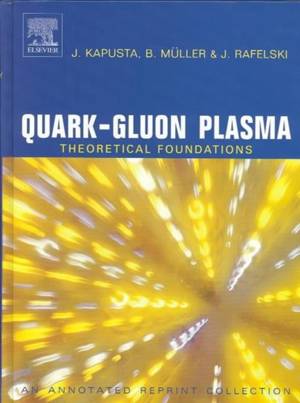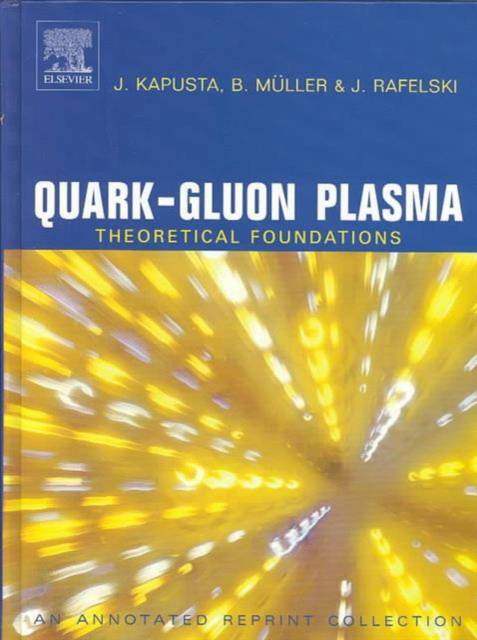
- Retrait gratuit dans votre magasin Club
- 7.000.000 titres dans notre catalogue
- Payer en toute sécurité
- Toujours un magasin près de chez vous
- Retrait gratuit dans votre magasin Club
- 7.000.0000 titres dans notre catalogue
- Payer en toute sécurité
- Toujours un magasin près de chez vous
Quark-Gluon Plasma: Theoretical Foundations
An Annotated Reprint Collection
J Kapusta, B Müller, J Rafelski
Livre relié | Anglais
279,45 €
+ 558 points
Description
The purpose of this volume is to trace the development of the theoretical understanding of quark-gluon plasma, both in terms of theequation of state and thermal correlation functions and in terms ofits manifestation in high energy nuclear collisions. Who among us hasnot wondered how tall a mountain is on a neutron star, what happenswhen matter is heated and compressed to higher and higher densities, what happens when an object falls into a black hole, or what happenedeons ago in the early universe? The study of quark-gluon plasma is related in one way or another to these and other thought provoking questions. Oftentimes the most eloquent exposition is given in theoriginal papers. To this end a selection is made of what are themost important pioneering papers in this field. The early 1950s wasan era when high energy multiparticle production in cosmic rayinteractions attracted the attention of some of the brightest minds in physics, and so it should be no surprise that the first reprinted papers deal with the introduction of statistical models of particleproduction. The quark model arose in the 1960s, while QCD as suchwas recognized as the theory of the strong interactions in the1970's. The behavior of matter at high temperatures and supranucleardensities became of wide interest in the nuclear and particle physicscommunities starting in the 1970s, which is when the concept ofquark-gluon plasma became established. The history of the field hasbeen traced up to the early 1990s. There are three reasons forstopping at that point in time. First, most of the key theoreticalconcepts and formalisms arose before 1993, although many of themcontinue to be developed today and hopefully well into the future. Second, papers written after 1992 are much more readily availablethan those writen before due to the advent of the World Wide Web andits electronic preprint databases and journals. Finally, in makingthis collection of reprints available as hardcopy one is limited inthe number of pages, and some papers in the present selection shouldhave been deleted in order to make room for post-1993 papers. For thesame reason the subject focus must of necessity be limited, whichmeans that in this reprint collection two wide subject areas are not addressed: the behavior of nuclear matter under extreme conditionsis not reported, nor is quark matter in neutron stars. The broadcategories into which the material has been placed, reflect thediverse studies of quark-gluon plasma and its manifestation. They are: phase-space models of particle production, perturbative QCDplasma, lattice gauge theory, fluid dynamics and flow, strangeness, heavy flavor (charm), electromagnetic signals, parton cascade andminijets, parton energy loss and jet quenching, Hanbury Brown--Twiss(HBT) interferometry, disoriented chiral condensates, phasetransition dynamics and cosmology, and color superconductivity. Eachchapter is prefaced by an introduction, which contains a list ofsignificant papers which is more complete than the reprinted papers, though by no means exhaustive. It also contains citations to mostrelevant papers published up to the date of completion of this volume(fall 2002). It is hoped that the short reviews will help bring thereader up to date on the latest developments. The selection ofpapers cited in each chapter, and in particular the ones selected forreprinting, is solely the responsibility of the Editors. It is basedon their best judgement and experience in this field dating back tothe mid-1970s. In order to be reprinted a paper must have beenpioneering in the sense of originality and impact on the field.Generally they have been cited over a hundred times by other paperspublished in refereed journals. The final selection was reviewed anddiscussed among the Editors repeatedly. Just because a paper is not included does not mean they do not know of it or do not have a highregard for it. All of the papers cited or reprinted are originalresearch contributions. There are three other types of publicationslisted. The first is a compilation of books. The second is a listof reviews, many of which contain a significant amount of original material. The third is a list of the proceedings of the series ofQuark Matter meetings, the primary series of internationalconferences in this field that is attended by both theorists andexperimentalists.
Spécifications
Parties prenantes
- Auteur(s) :
- Editeur:
Contenu
- Nombre de pages :
- 836
- Langue:
- Anglais
Caractéristiques
- EAN:
- 9780444511102
- Date de parution :
- 25-11-03
- Format:
- Livre relié
- Format numérique:
- Genaaid
- Dimensions :
- 202 mm x 264 mm
- Poids :
- 2100 g

Les avis
Nous publions uniquement les avis qui respectent les conditions requises. Consultez nos conditions pour les avis.






